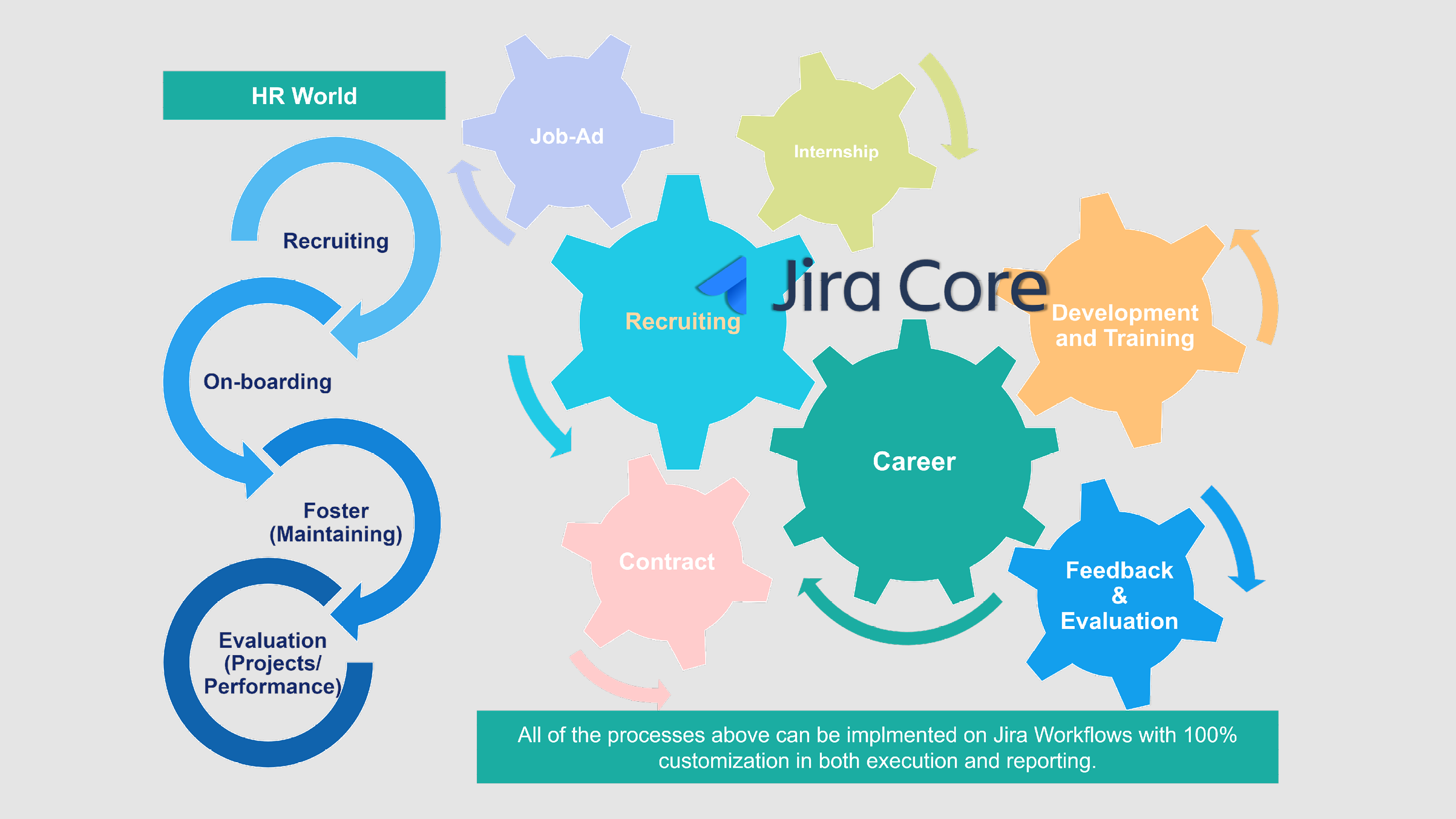The concepts of end-2end process management and collaborative knowledge management are now more than a decade old. Managing processes and knowledge efficiently and holistically is one of the most important success factors of innovative and agile companies. Nevertheless, these new concepts have not yet been adapted in most established organizations. The reason for this may be that the Pre-DevOps technologies and platforms were too complex to be agilely adapted. The new development technologies significantly reduce the development and maintenance costs of modern tools. The new approach should therefore no longer be ignored.
By minimizing programming and opening the platform to third-party vendors through one marketplace, Atlassian has succeeded in providing two platforms that realize a long-awaited, dynamic and innovative vision of end2end and collaborative process and knowledge management. And all this at considerably less cost compared to the current market leaders. On average, the development time is about 5 times faster, and the development costs are up to 10 times lower, combined with improved usability.

Jira and Modern End2End Process Management
Many years ago, older solutions tried to simplify company-wide process management. They were not convincing despite their over-standardization and their minimal expectations. Generic components for different processes, with or without an End2End approach at high adaptation costs, have discouraged companies from expanding their IT budget and investing.
Due to the new possibilities offered by modern web technologies and end devices, today's customers have new requirements and higher expectations regarding the usability, adaptability and intuitiveness of new IT systems. This is where today's IT systems reveal their shortcomings and weaknesses. Many of these systems are a labyrinth of systems and subsystems designed to maximize license fees rather than customer satisfaction. Above all, they have led to high costs in development, maintenance and customization, but also cost a lot of time and resources for training.
Companies have been forced to adapt their processes to the standard functions of applications, to create incomprehensible workarounds or to pay a high price for a laborious adaptation. Agility and dynamism fell by the wayside. In today's changing world and the constant emergence of new disruptive technologies, the requirements of these systems are constantly changing. The technology behind the established solutions is only conditionally suitable for agile, dynamic and scalable development.
The introduction of a new approach to defining web forms, actions, permissions and communications with just a few clicks, without the need for extensive programming, showed new ways. Modern platforms such as Drupal, WordPress, Salesforce and Jira stand for this new approach, which offers flexibility, security, transparency and quality never before seen in the BPM industry. Minimizing coding led to the possibility of modular configuration that is easier and faster to develop, test, deploy, and document. The DevOps concept was born.
Possibilities of Jira as a flexible "workflow engine"
Any process that does not rely on complex calculations or user interfaces can be created with Jira as a flexible and highly customizable workflow engine. To add charm, appropriately selected apps (plug-ins) can be added to meet specific requirements that are not provided out-of-the-box by Jira. This combination leads to the fact that End2end processes can finally be implemented as they were designed: integrated, personal and comprehensive.
Let's look at recruitment processes, for example.
The recruitment process includes:
1.the maintenance of requirements for specific positions,
2.the preparation and placement of a job advertisement,
3. the receipt of applications,
4. the review of applications,
5. conducting interviews,
6. the decision to hire someone,
7. preparing, exporting and signing a contract on the basis of agreed terms and conditions
8. and the final preparation of the IT and organizational structure for the new employee (onboarding).
Many companies use different tools to manage specific parts of this process. In many cases, these systems do not interact with each other. This means that the processing of job advertisements is completely isolated from the application review and applicant evaluation, which is separate from the department responsible for contract drafting.
This uncoordinated set of tools places a heavy technical burden on IT, an unnecessary cognitive burden on HR staff and, last but not least, a costly process to obtain meaningful and comprehensive reports on the status, costs and other KPIs of the application process.
With a modern platform like Jira, all existing and necessary steps can be covered during the entire application process from the definition of a job advertisement to the entry of the new employee. And when a platform is used to support all the necessary steps within a process, it is not necessary for another BI tool to collect relevant information and deliver meaningful reports. The reports can be created easily, in real time and well integrated with all other relevant parts of the process.
The exemplary application process described above can be applied to all other processes in a company, from compliance to IT support, career management, budgeting, training, purchasing, etc. The application process can also be used as a model for other processes. The advantages are enormous.
Pros and challenges of Jira
Pros
As already mentioned, the use of Jira as a homogeneous, DevOps-oriented and dynamic platform for process management significantly reduces the number of silo applications (shadow IT) officially or otherwise used (the same applies to the use of Trello for organizing tasks and thoughts and of Slack for structuring communication). It also helps to realize an end-to-end interpretation of the relevant processes. Reporting and controlling is also much more efficient and faster, since the data is processed centrally or in well integrated systems and not in numerous tools, Excel files and e-mail accounts. Systematic data collection and processing also leads to improved data protection (e.g. DSGVO conformity).
The open and mobile character of Jira makes it possible to increase efficiency and transparency in communication, monitoring and process control. The implementation of workflows and the configuration of dashboards, notifications and communication methods can be done in a few days and not months. Those who leave obsolete systems such as LotusNotes in favor of DevOps-oriented platforms such as Jira will experience a dramatic increase in usability, data efficiency and quality, satisfied employees, as well as a significant reduction in costs and time for development/adaptation. All that needs to be overcome is the fear of change and the opposition of the political lobby to the use of old but established tools.
Reducing complexity and increasing ease of use inevitably leads to lower costs and increased employee and customer satisfaction as manual work is minimized in the execution of processes, report creation and approval is simplified and made more transparent, communication is clearer and cognitive strain (using outdated solutions) is reduced. And let's not forget the huge reduction in IT administration and service costs, where slow and unnecessarily complex tools are replaced by modern and modular platforms that are easier to configure and maintain.
What is the challenge?
Of course, the conversion to modern and thus web-based technologies presents a company with new challenges. A company that previously used Excel, e-mail and desktop applications intensively now needs new authorization and role concepts in order to be able to use online and synchronized solutions. So a clean area-wide analysis must be carried out in order to adapt and implement the new systems correctly from the outset.
Security concepts are obsolete in most companies and the attitude "as long as it is on my PC, it is safe" has been lived for a long time. With the new approach, sensitive company information and data is stored on enterprise-wide servers (or in the cloud).
Anyone on the network could potentially access the data if the permission and security concept was not properly designed. In particular, designing a personal yet comprehensive solution poses a particular challenge that is not easy to address. The collection of requirements with an End2End overview and the corresponding architecture design requires experienced system architects who have dealt with possible applications of new technologies.
In addition to new authorization and role concepts, the selection of the right plugin set is another challenge when implementing customized end2end processes in Jira. Functionalities can be implemented in a variety of ways. Not all of them are scalable, flexible or user-oriented. Experienced system architects are required to find the perfect constellation of plug-ins with the corresponding configuration and integration. In this way, a basis can be created that can be developed and scaled quickly and securely, whereby the needs and abilities of the users are in the foreground.
However, mastering this organizational and process-related transformation is not only worth the effort, but a necessity if a company wants to remain competitive in the market. A successful transition and targeted transformation leads to more dynamism and agility, lower costs and better usability, as the tools are constantly and quickly adapted to the actual needs and business requirements of the users.
Atlassian Elite Taskforce (AET) @ Detecon
At Detecon, a designated Atlassian Elite Taskforce (AET) has been formed, concentrating on Atlassian products, in particular Jira & Confluence. The task force is responsible for the implementation of projects, the collection of best practices and the evaluation of methods, approaches and architects. In various projects, a number of methods and reference models have been developed to measure the maturity of each enterprise architecture and create a roadmap for the transition from outdated and expensive solutions. With this experience and knowledge, we support companies that take the courageous step of transformation and modernize their infrastructure with Atlassian Glue.
The author of the article is Dr. Pujan Ziaie.






